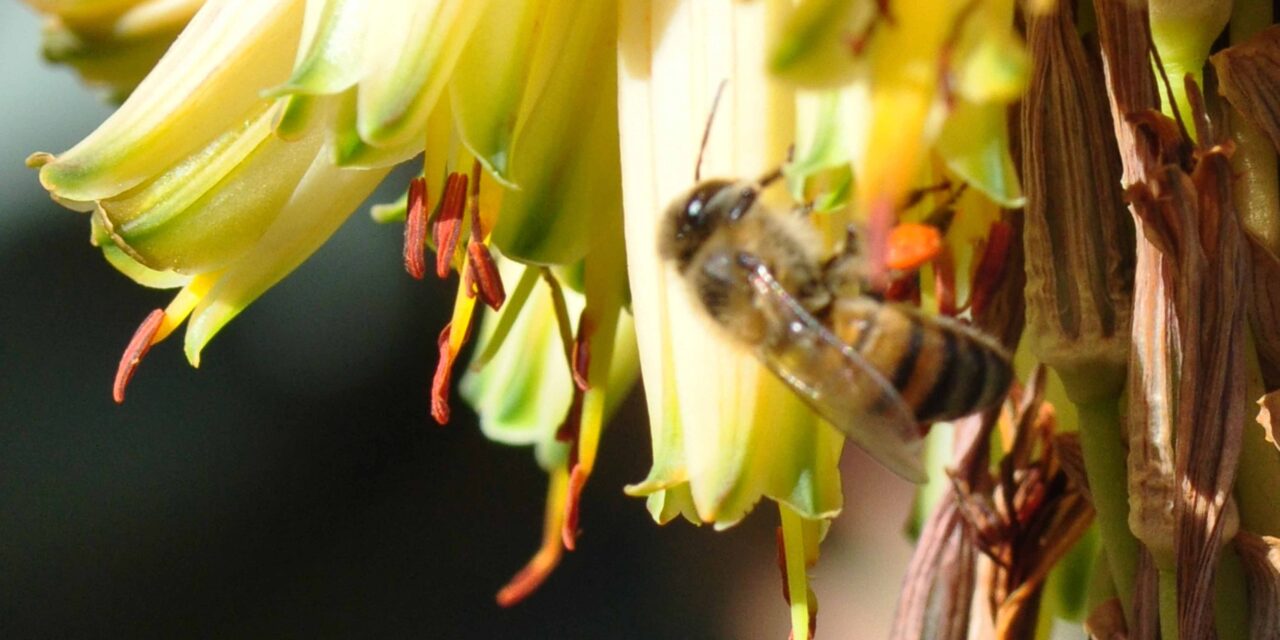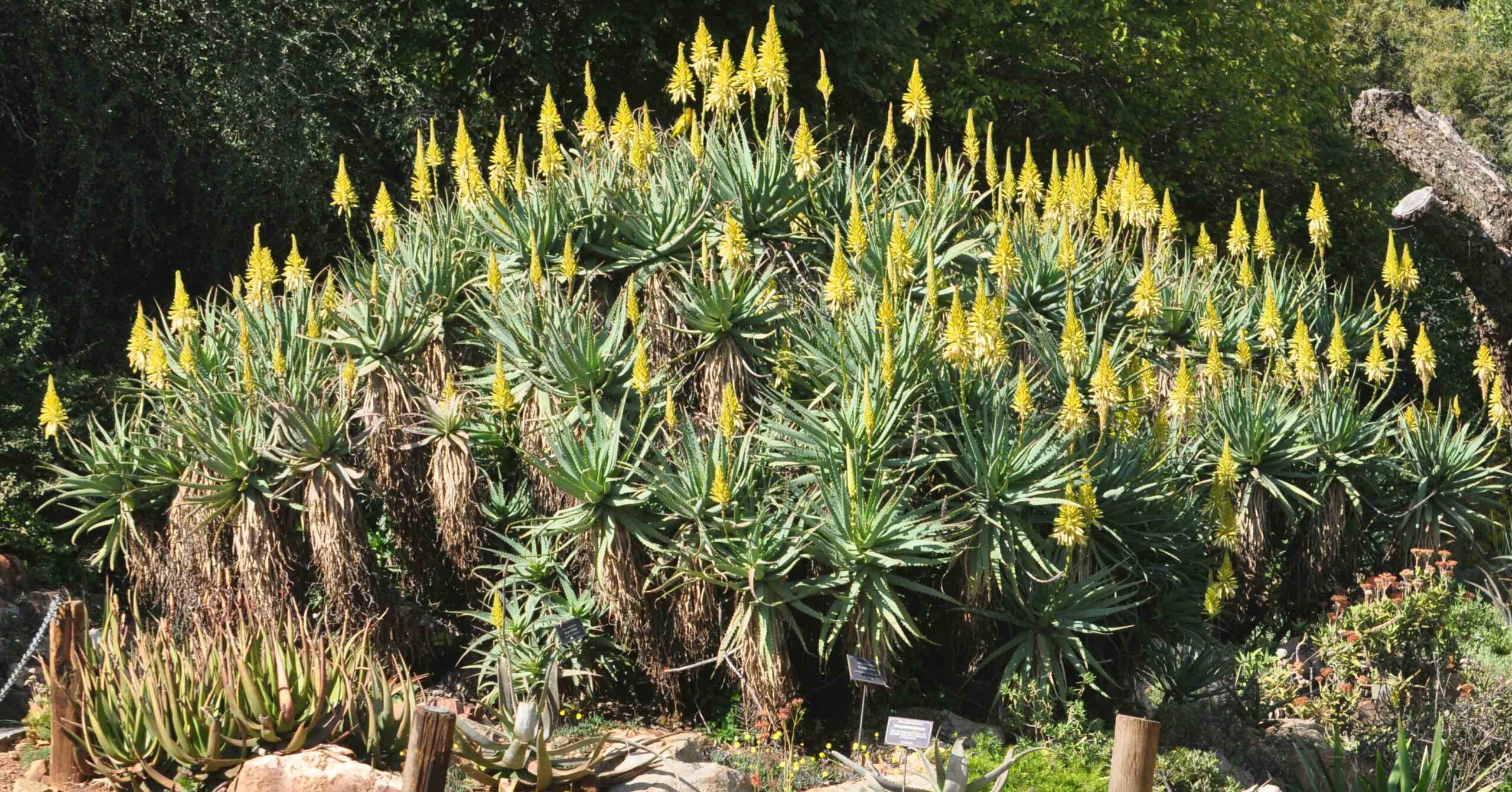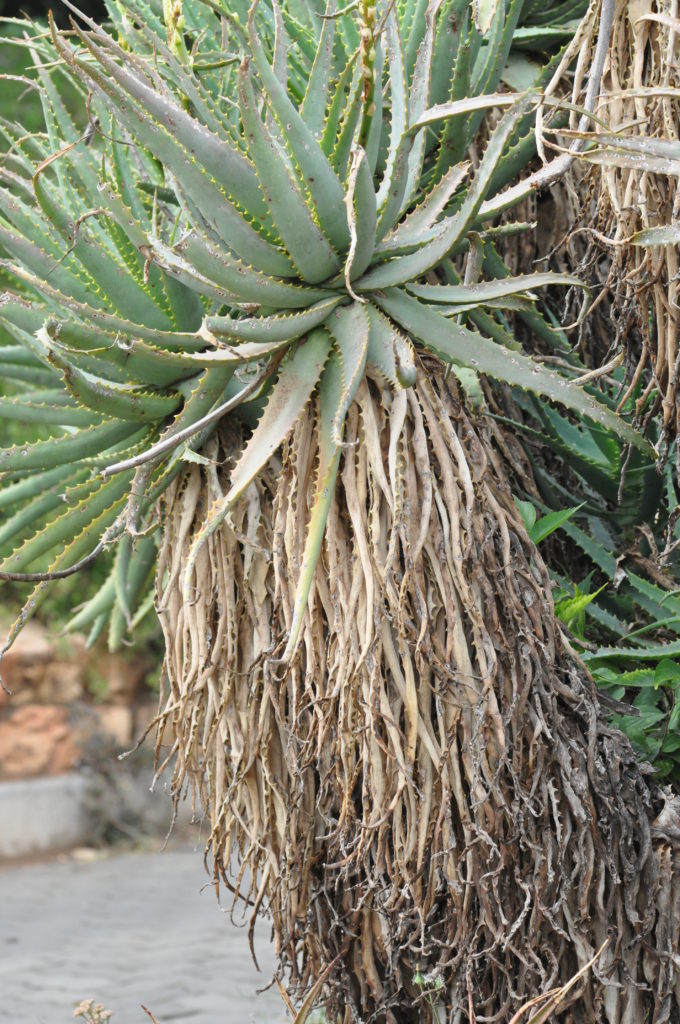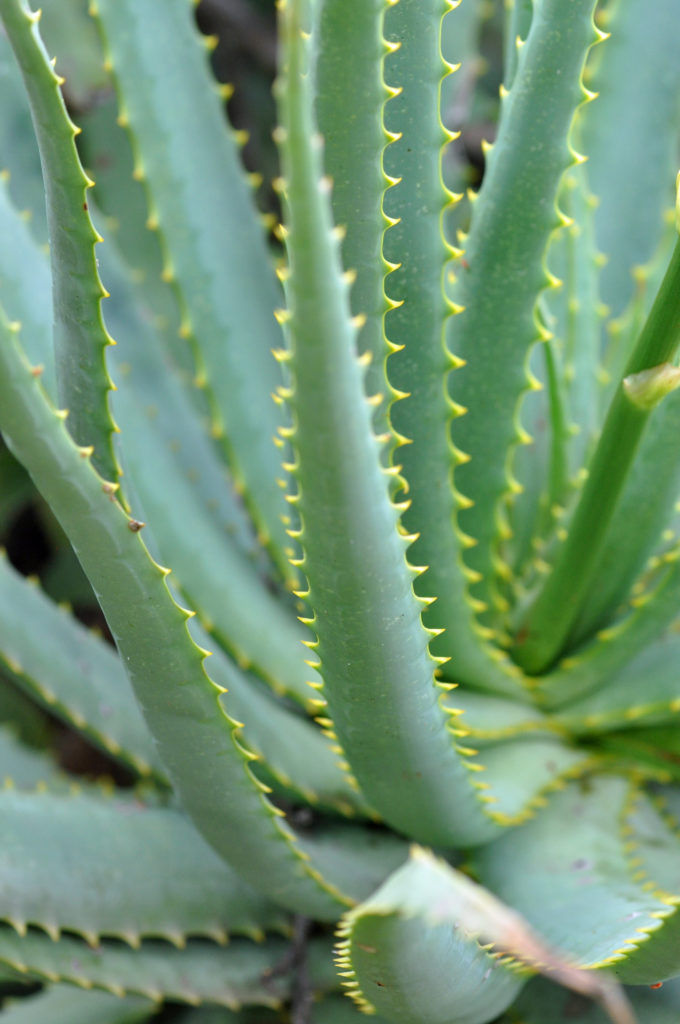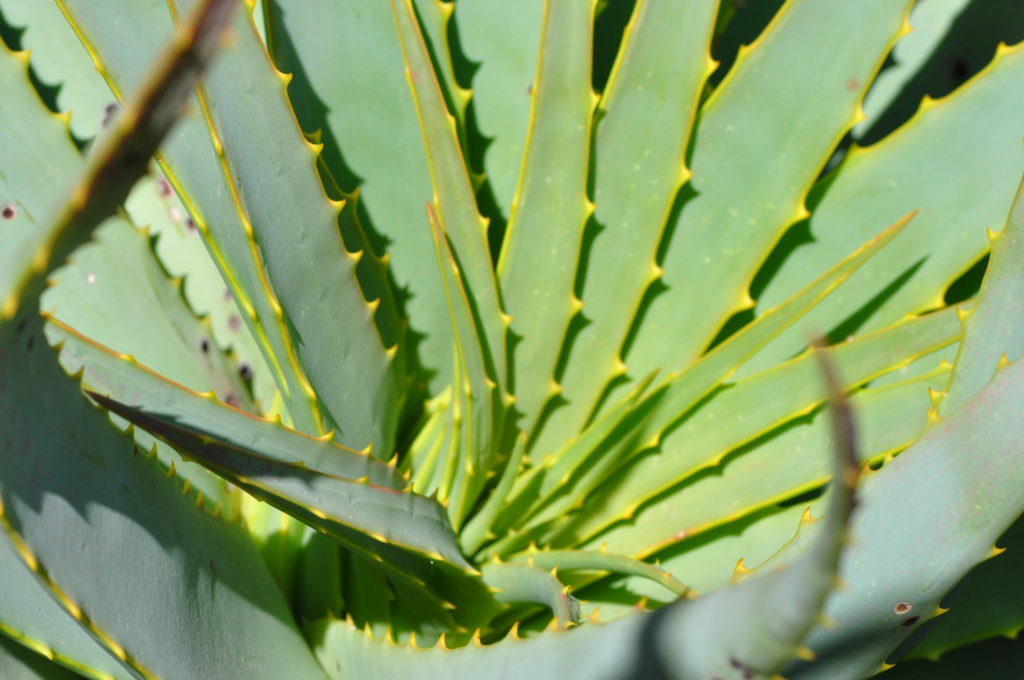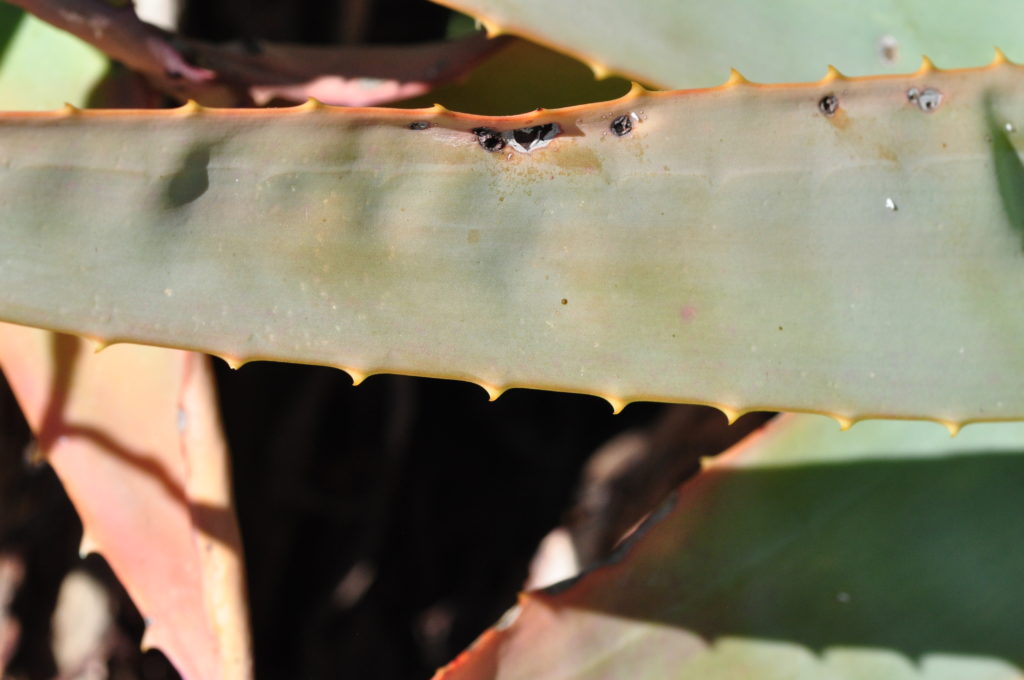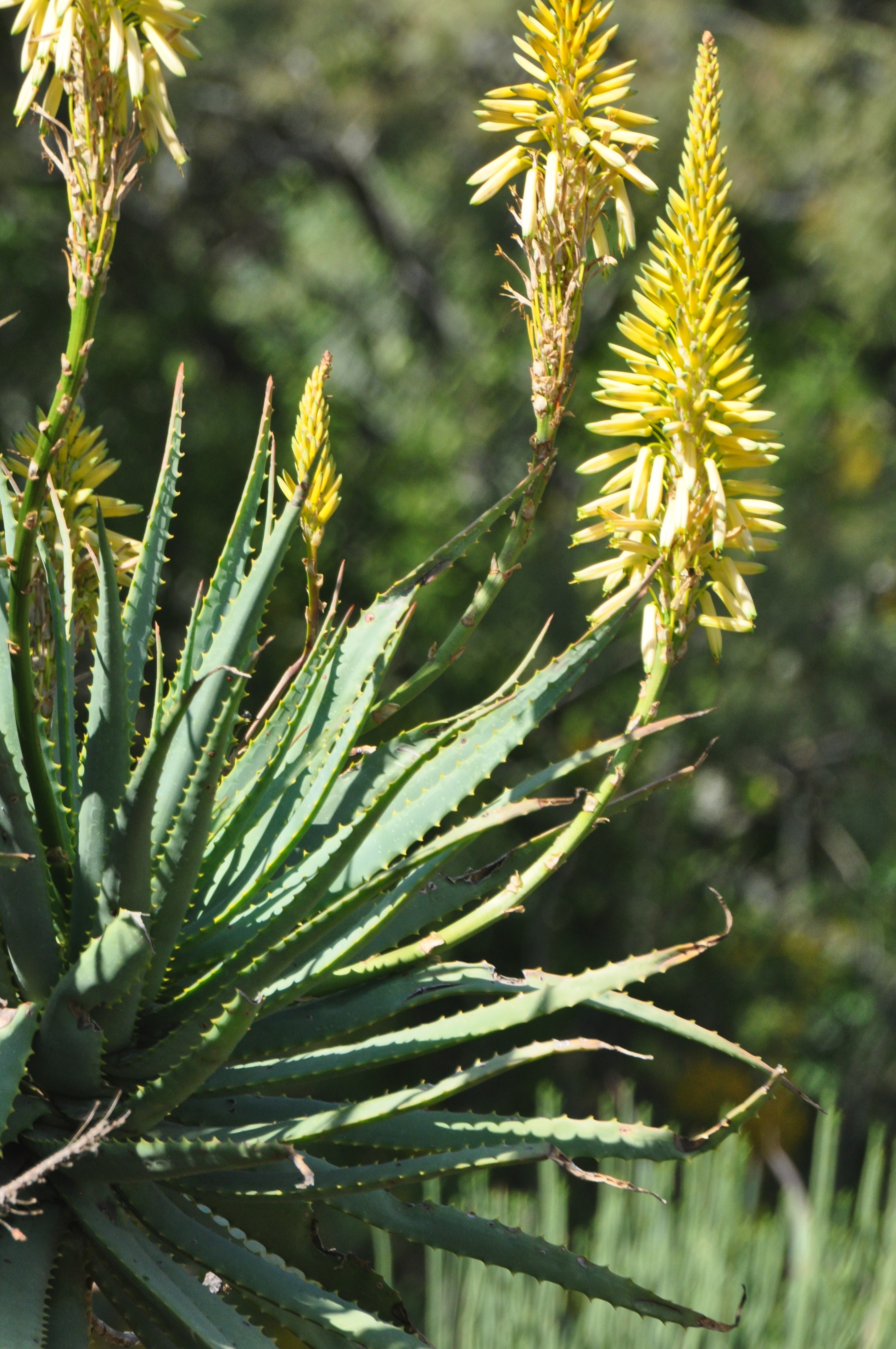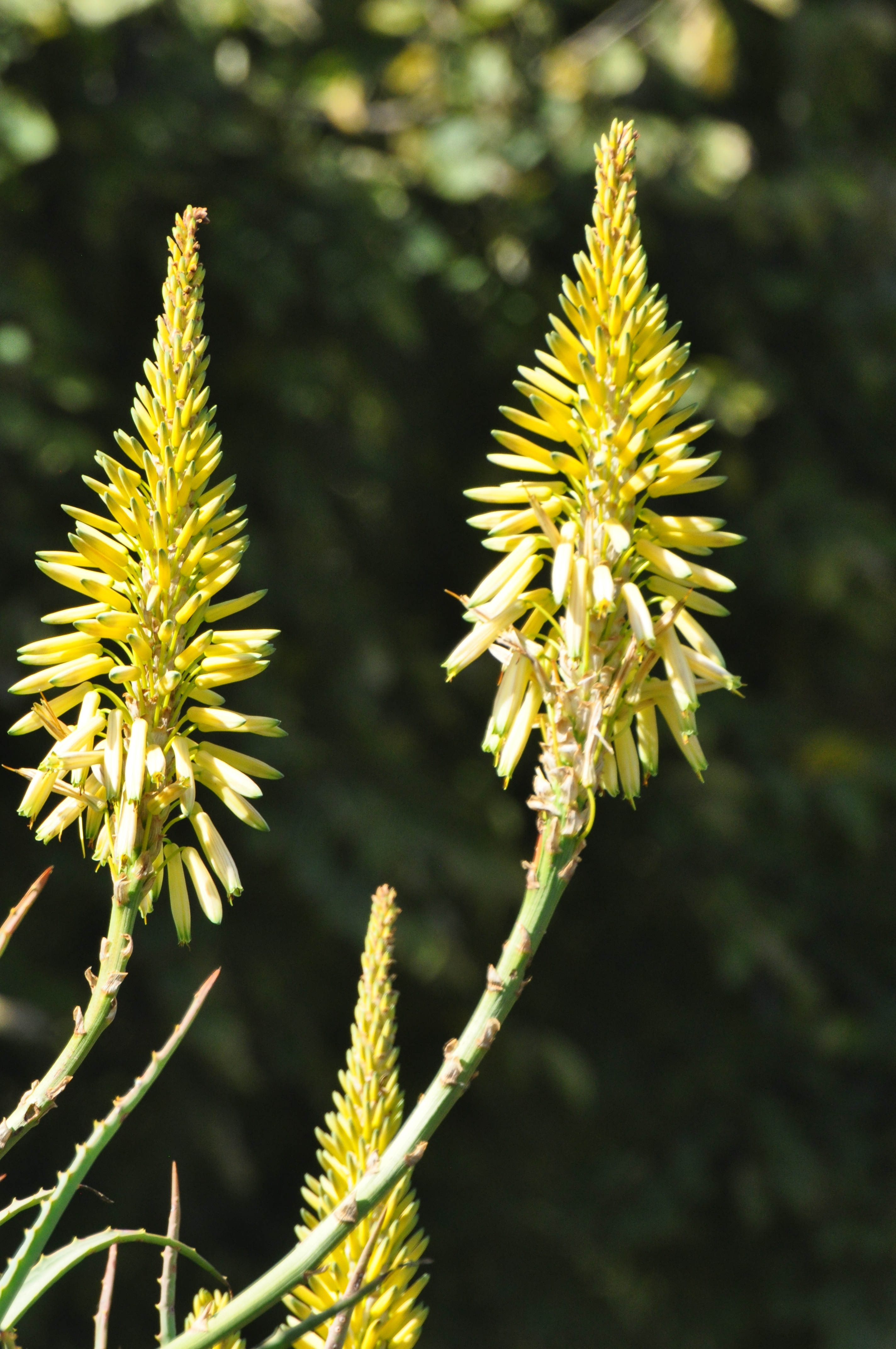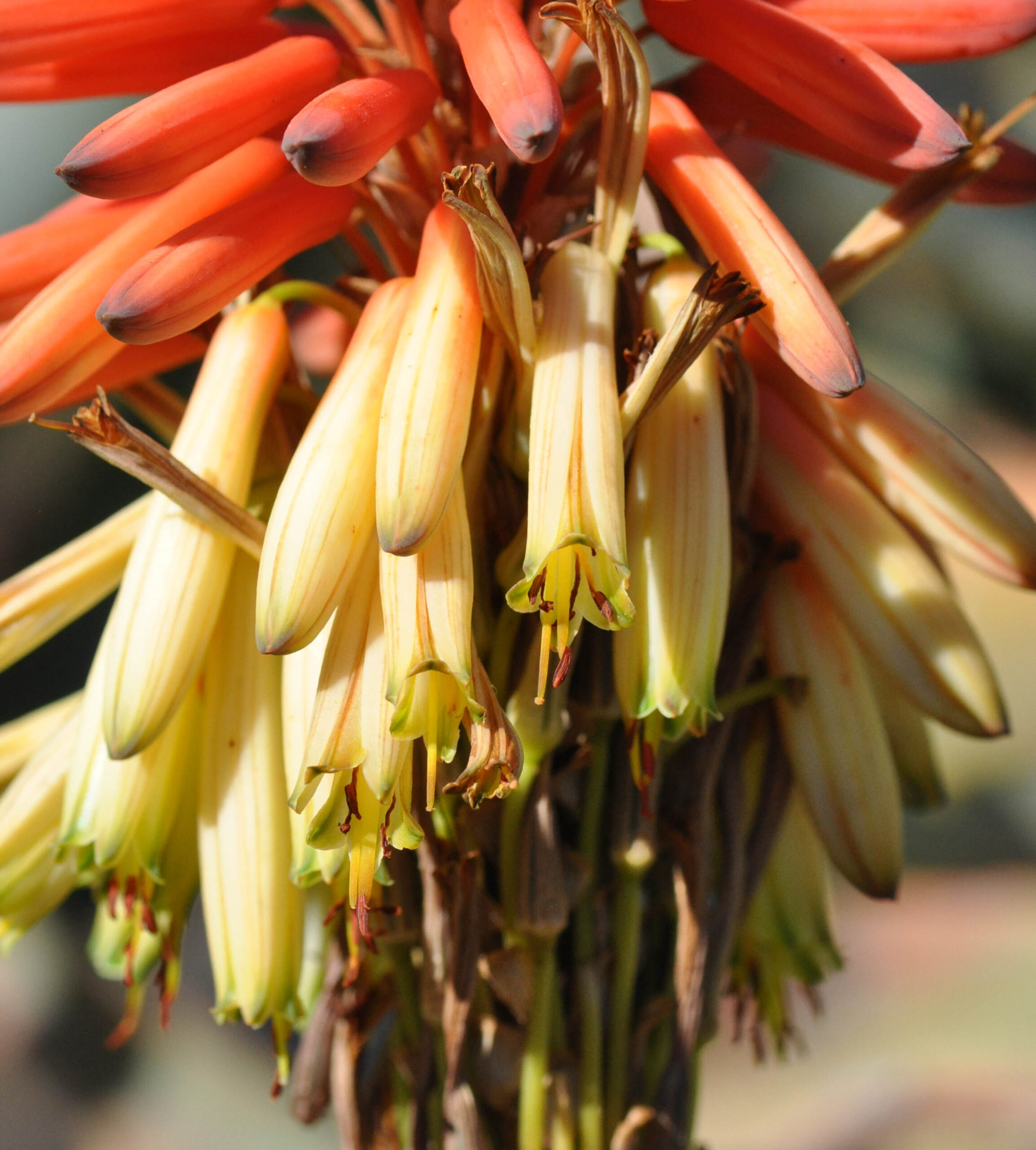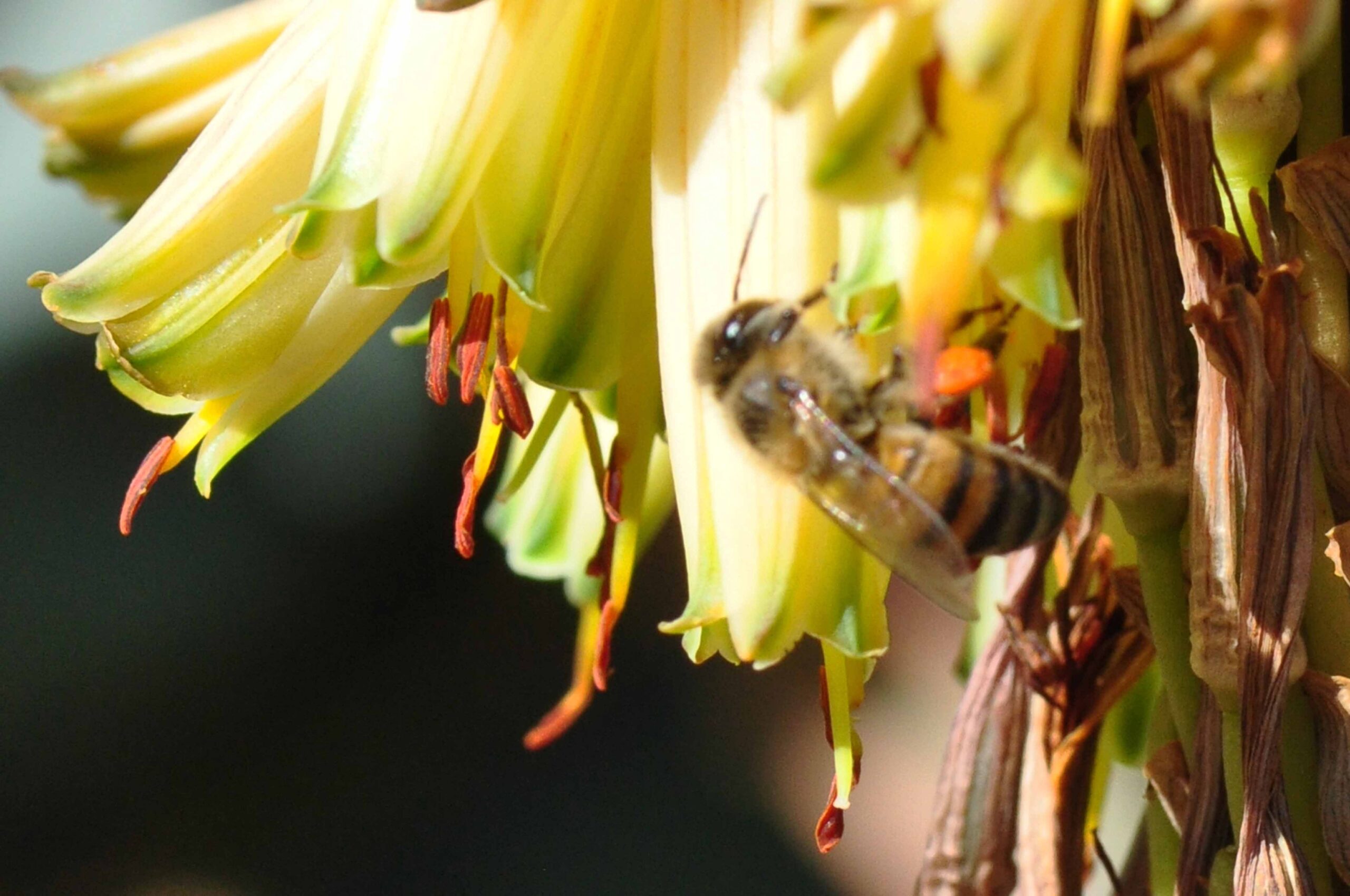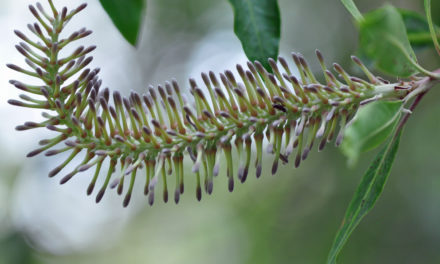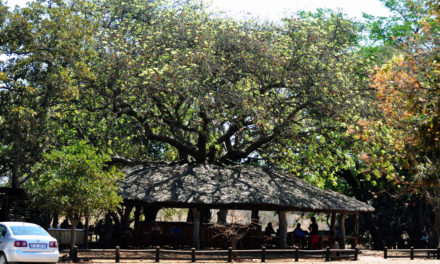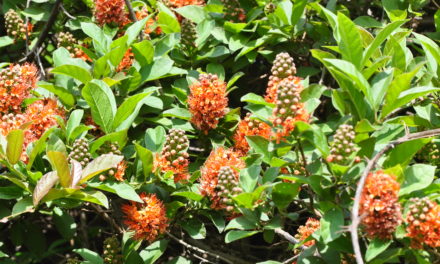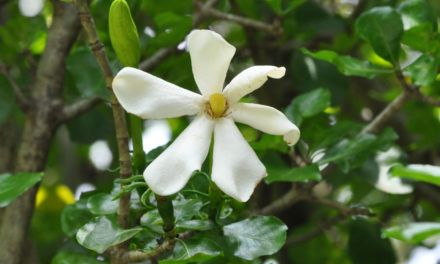General Info – summary
This Tree is up to 3m high but is usually a much branched & a widely distributed shrub. Succulent Leaves + amplexicaul bases, are narrow, thick, curved & collectively rosulate. Only margins have spines. Shrunken old leaves remain. Bisexual, regular, tubular Flowers have 2 rows of 3 tepals. Flowers occur in broadly conical racemes. Fruit is an erect truncate, cylindrical capsule with compressed, obscurely winged seeds.
Description
Aloe arborescens
Previous Names: Aloe arborea, Aloe frutescens, Aloe fruticosa, Aloe mutabilis, Aloe natalensis, Aloe perfoliate, Catevala arborescens.
SA Tree No. 28.1.
Common names: (Afr) Kransaalwyn, Krans-aalwyn. (Eng) Krantz Aloe, Mountain Bush Aloe. (isiXhosa) Ikhala, Ingcelwane, Unomaweni. (isiZulu) Inhlaba-encane, Inhlazi, Inkalane, Inkalane-encane, Inkalene, Inkalene-encane, Umhlabana. (Northern Sotho) Sekgopha. (siSwati) imBovane, Incena. (Tshivenda) Tshikhopha. Krantz is a precipitous or overhanging wall of rocks.
Family: Asphodelaceae (Aloe Family). Presumably derived from Asphodel Meadows, which is a section of the Ancient Greek underworld where indifferent and ordinary souls were sent to live after death. The family has about 40 genera and 900 species. There are 10 genera in South Africa. This is a small but widespread, mainly African family of perennial plants. All have Anthraquinones (an aromatic, organic compound, which is the main active constituents of herbs – often used to relieve constipation and may possess antifungal and antiviral activities. They are also widely used in dyes). When present, the Stems are fibrous and woody. The fleshy Leaves often have spines either on the margins or on the blades. The outer 2 flower whorls (the Perianth) lack the classic distinction between calyx and corolla and the lobes are called Tepals. These 2 whorls each have 3 tepals. Flowers are usually borne on a leafless stalk arising from the rosette of leaves. Individual flowers are regular. The 6 Stamens are inserted in 2 whorls of 3, below the superior 3 locular Ovary. Fruit is usually a dry Capsule. Genera with trees on this website include Aloe, Aloidendron and Kumara.
The name Aloidendron or ‘tree aloe’ dates to 2013 and is thanks to molecular studies that are rather shaking up phylogenies and thus classifications. About 20 of these are considered to be trees. The rambling aloes have also been put in their own genus: Aloiampelos.
Name derivation: Aloe – origin unclear possibly referring to the bitter juice. arborescens – becoming tree-like, but this aloe does not usually look like a tree. A number of hybrids do exist.
Conservation: National Status: L C. (Least Concern). Assessment: 2018 (H. Mtshali and L. von Staden). The stable population is widespread and common.
Tree
This small, attractive, perennial and low-down branching Tree may reach 3m high but is usually a much-branched succulent shrub. The main stem/trunk is short. Aloe arborescens is the third most widespread of all aloes. The many compact, slender branches develop low down, and the plant usually reaches about the same width as its height. The picture below is of many individual plants. The succulent Roots are terete (circular in cross section).
- 153 2002/12/08. Walter Sisulu NBG. Photo:David Becking.
Leaves
The thick, curved, narrow and succulent Leaves are dull greyish green or bluish and may be slightly sickle shaped. Each leaf, tapers towards the tip and, collectively, are rosulate (radiating from a crown or centre – forming rosettes – photos 409 & 472). Weather may affect the colour. In times of drought or cold weather, they turn reddish (photo 410). The leaf Apex is acute, and the Base is amplexicaul (one that embraces and surrounds a stem). The rather narrow leaf Blade (photo 472) is up to 60 x 7cm. The evenly spaced teeth only occur on the Margin. These teeth have a green base, and the sharp end is a pale yellow (photo 472). Teeth may be curved and point slightly towards the leaf apex. The dry, old, light grey, shrunken, leaves remain attached to the stem – somewhat like a beard (photo 473). These occur below the rosette of young leaves.
- 473 2016./05/10 Walter Sisulu NBG. David Becking.
- 472 2016/05/10 Walter Sisulu NBG. David Becking.
- 409 2016/07./19 Walter Sisulu NBG. David Becking.
- 410 2016/07/19 Walter Sisulu NBG. David Becking.
Flowers
Many individual Flowers usually develop in each short, compact Raceme (a simple, unbranched, indeterminate Inflorescence with stalked flowers along the axis that open in succession towards the apex – photo 155). Racemes are up to 80cm long and up to 4 racemes can emerge from each rosette (an arrangement of leaves radiating from a crown or centre of leaves). Individual flowers have a Pedicel (stalk of a single flower) that is up to 4cm long. Flowers are tubular, bisexual and actinomorphic (Regular, symmetrical. Flowers are up to 4cm long and vertically divisible into similar halves by more than 1 plane passing through the axis). The Flowers are usually red may be orange, coral pink, yellow (photo 154) even bicoloured and up to 6cm long. The Perianth (a collective term for the not clearly differentiated calyx and corolla) parts are called Tepals. These tepals are petaloid (resemble petals). Inside the perianth are 6 exserted (sticking out) Stamens (photo 405). Here each thin free Filament ends with a red Anther (photo 405) that is dorsifixed and opens longitudinally to release pollen. The Pistil (a unit of the Gynoecium, the female element of the flower, composed of the Ovary, Style and Stigma) has a superior, trilocular Ovary. The single filiform (thread or filament like) Style protrudes beyond the perianth and just past the anthers (photo 400 – centre flowers). (Apr-Jul).
- 154 2016/05/31 Walter Sisulu NBG. David Becking.
- 155 2016/05/31 Walter Sisulu NBG. David Becking.
- 400 2016/07/19 Walter Sisulu NBG. David Becking.
- 405 2016/07/19 Walter Sisulu NBG. David Becking.
Fruit
The erect, cylindrical Fruit is a Capsule (a dry fruit resulting from the maturing of a compound ovary). Here the ovary is divided into 3 chambers and the apex is truncate (appearing as if cut of at the end). The fruit is up to 22 x 7mm. It contains laterally compressed Seeds that are obscurely winged.
Distribution & Ecology
This widely distributed Aloe is often most numerous on south and eastern mountain slopes. It occurs naturally on rocky hillsides and cliffs – in high rainfall, often cool areas, e.g. Kowyn’s pass (between Graskop and Bosbokrand in Mpumalanga). It is reasonably frost resistant and this possibly helps it to grow from close to sea level (including coastal bush) to about 1 900m above sea level. Few aloes have this range and, as a result, it is the most widely distributed aloe species in South Africa – spanning in excess of 1 600 sq km (including bare mountainsides). This plant is Endemic in Southern Africa. It is Found from Genadendal in the Western Cape, Eastern Cape, KwaZulu-Natal, Swaziland, Mpumalanga, Gauteng, North West, Limpopo, and as far north as Mozambique, Zimbabwe and Malawi. This plant hybridises with a number of other aloes. Flowers produce a large quantity of Nectar, which attracts birds, especially sunbirds and insects like bees (photo 405 under Flowers) and butterflies. These animals are the pollinating agents. In winter when water is frozen, the nectar may remain liquid, and this attracts children and animals like baboons and monkeys. The Buds, with their green tips (photo 400 under Flowers), initially point upwards but when the flowers open, they bend and point downwards (photo 155). This allows the bees to enter and exit (important) with relative ease.
Ethnobotany
This plant is an asset to a garden and becomes spectacular when flowering. As early as 1689 seeds were sent and raised in Europe. Once established, it needs little care. This much-appreciated plant was widely planted in Europe by 1700. It is planted as a living fence in the Eastern Cape and parts of the Western Cape. Propagation can be from seeds, which take a few weeks to germinate and are generally slow growing. Cuttings are the easiest method of propagation – producing genetically identical plants. Plant in well-drained, sunny spot. Plant extracts decrease wound healing time and bacterial growth. The Gel-like pulp from the Leaves is used to treat burns – including X-ray burns. The old dry leaves make a good fire starter. They burn for a short time with intense heat. This plant is grown as a hedge and is used in local medicine. It has now been widely planted in Australia, South Korea, Japan and the Western Mediterranean.
References
Boon, R. 2010. Pooley’s Trees of eastern South Africa. Flora and Fauna Publications Trust, Durban.
Burrows, J.E., Burrows, S.M., Lotter, M.C. & Schmidt, E. 2018. Trees and Shrubs Mozambique. Publishing Print Matters (Pty) Ltd. Noordhoek, Cape Town.
Coates Palgrave, M. 2002. Keith Coates Palgrave Trees of Southern Africa, edn 3. Struik, Cape Town.
Lawrence, G. H. M, 1951. Taxonomy of Vascular Plants. The Macmillan Company, New York. Tenth Printing 1965.
Mtshali, H. & von Staden, L. 2018. Aloe arborescens Mill. National Assessment: Red List of South African Plants version 2020.1. Accessed on 2022/12/07.
Palmer, E. & Pitman, N. 1972. Trees of southern Africa. Balkema, Amsterdam, Cape Town.
Schmidt, S. Lotter, M. & McCleland, W. 2002. Trees and Shrubs of Mpumalanga and the Kruger National Park. Jacana, Johannesburg.
van Wyk, B. & van Wyk, P. 1997 Field guide to Trees of Southern Africa. Struik, Cape Town.
http://plantzafrica.com/plantab/aloearbor.htm
https://en.wikipedia.org/wiki/Aloe_arborescens
http://posa.sanbi.org/flora/browse.php?src=SP
https://en.wikipedia.org/wiki/Asphodelaceae

